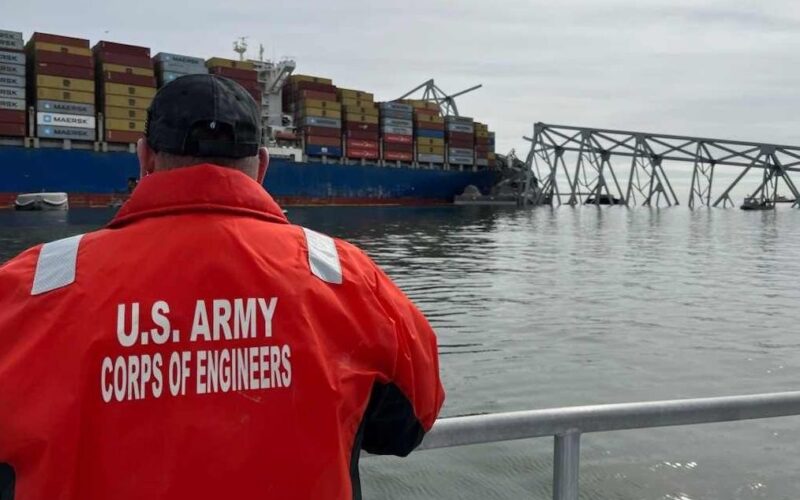(BALTIMORE) — The U.S. Army Corps of Engineers (USACE) Baltimore District has activated its emergency operations center, clearing the way for engineering, construction, contracting and operations specialists to begin the complex process of clearing the damage and debris along the Fort McHenry Channel following the collapse of the Francis Scott Key Bridge, to restore safe navigation in and out of the Port of Baltimore.
Together, through the efforts of the unified command, USACE is working to determine the actions required to remove the fallen debris. Preliminary underwater analysis and assessment is currently underway, providing critical data that will assist in future operations.
The data collected during this process will help determine the operational plan moving forward needed to reopen the federal channel.

“We continue to provide our best talent and technology in support of the Coast Guard and our local, state and federal partners,” said USACE Commanding General Lt. Gen. Scott Spellmon. “The U.S. Army Corps of Engineers is responsible for engineering solutions to our nation’s toughest challenges, and this disaster constitutes one of those top challenges. It requires a deliberate, diligent engineering strategy, based on careful assessments of the disaster site, and with safety as our top priority.”
As of March 30, USACE is providing:
• Certified underwater assessment capabilities by structural professional engineers, remotely operated vehicle and sonar;
• Structural engineering support, including certified bridge safety inspectors and urban search and rescue structural technical specialists;
• Waterway debris management, led by USACE debris removal vessel Reynolds, which patrols the waters of the Baltimore Harbor and Patapsco River for drift and debris that could be hazardous to navigation;
• Hydrographic and topographic surveying via Catlett, a 61-foot survey vessel that actively supports the Baltimore District’s Navigation Branch. Two survey vessels from USACE, Philadelphia District, H.R. Spies and Dauntless, are also providing support.
USACE is also poised to provide the following support to the joint response:
• Additional USACE vessels are prepared to join efforts as needed for waterway debris management, led by USACE debris removal vessel Reynolds;
• USACE dive safety experts from the Philadelphia, Buffalo and New England districts are preparing to join the response effort.
The Baltimore District operates and maintains more than 290 miles of federal navigable channels within the Susquehanna River watershed, including the Fort McHenry Channel.
“We have marshaled incredible skills and the best equipment available. I am fully confident that we have the right team and partners in place to tackle this project and do what we do best – serve and strengthen this great nation,” said USACE Baltimore District Commander Col. Estee Pinchasin. “Many of our USACE Baltimore teammates were born and raised locally. We are deeply invested and fully committed. We are ready to get to work.”
– U.S. Army Corps of Engineers

